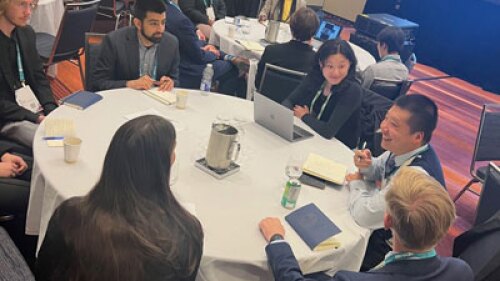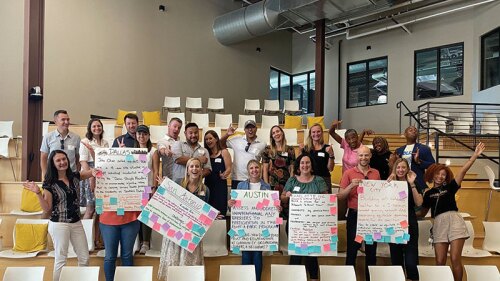By Katharine Burgess
ULI Baltimore recently supported the city of Annapolis, Maryland, on a long-range planning effort to protect the cultural and architectural assets of the city’s historic district against sea-level rise and other extreme weather events resulting from climate change. The district council has played a critical role in engaging the private sector and the wider Annapolis community on the issue of building resilience within urban areas.
Like other waterfront cities, Annapolis is contending with sea-level rise, an increase in urban flooding, and land subsidence or sinking. As part of its “Weather It Together” long-range planning effort, the city hosted a charrette in April that brought together ULI members and staff, Annapolis residents, and city of Annapolis planners and emergency managers to brainstorm strategies for protecting and preserving historic properties as extreme weather becomes more routine.
“Weather It Together” has been cited as an innovative example of public and private sector collaboration in resilience planning. In addition to ULI, project partners include the U.S. Federal Emergency Management Agency (FEMA) and the Maryland Emergency Management Agency (MEMA). The charrette was one of three ULI district council projects that received a grant through the ULI Urban Resilience Program that was funded by the Kresge Foundation and the ULI Foundation. ULI Baltimore was one of the partners recognized for its work on “Weather It Together” with a 2016 Maryland Preservation Award.
A historic maritime city and Maryland’s state capital, Annapolis is known for its scenic waterfront and colonial architecture. The downtown historic district has been a National Historic Landmark since 1965 and is a popular tourist destination. However, as one of the lowest-lying parts of the city, the historic district is particularly susceptible to flooding: “nuisance floods” now occur ten times more often than they did ten years ago, according to a 2014 National Oceanic and Atmospheric Administration (NOAA) study. Locals also still discuss the impact of Hurricane Isabel in 2003, which brought the tide 7.58 feet (2.31 m) above normal levels, filling classrooms and hallways at the U.S. Naval Academy.
Lisa Craig, chief of historic preservation for the city of Annapolis, led the charrette, which was attended by 75 people and held at a boat supply shop, whose parking lot routinely floods during high tide. “ULI is demonstrating a strong collaborative spirit . . . as part of our historic city’s ‘Weather It Together’ initiative,” she said. “They worked together to engage a dozen local and regional experts to assist us with our planning charrette, adding even more value to this ULI grant–funded community engagement program to adapt to sea-level rise in Annapolis.”
The charrette offered residents, professionals, and others the chance to learn from sea-level rise experts and brainstorm about how their historic city could adapt to changing conditions while retaining its charm. Institute staff presented findings from other ULI district council work, including ULI Boston’s Living with Water project, which identified strategies to build resilience at the property and district levels in Boston.
Charrette participants spent most of their day brainstorming at roundtables, each of which focused on a different policy area, including planning and land use, public education, building performance standards, adaptation options for private property, adaptation options for cultural resources protection, structural adaptation options, natural resources protection, and economic opportunities and implications.
The roundtable groups began by addressing the key challenges relevant to each topic area. As a next step, each group discussed how these challenges could be addressed through policy, regulation, and design. Finally, the groups prioritized challenges to be addressed in the short and long terms. These prioritizations will be addressed within the city’s new cultural resources hazard mitigation plan, as well as in topic-specific white papers.
In addition to the charrette, ULI Baltimore sponsored a community engagement trip by sea-level rise expert John Englander, author of High Tide on Main Street: Rising Sea Levels and the Coming Coastal Crisis. Englander’s visit in January 2016 included meetings with community members, specialist groups, property owners, and the maritime community, culminating in a public presentation at St. John’s College that drew nearly 600 people.
Kristen Mitchell, manager of infrastructure and development at the Maryland Department of Planning and a member of ULI Baltimore’s regionalism committee, described the community engagement trip as an important tool to present complex climate issues to a lay audience. “Science can be hard for people to grasp,” she explained. “[Englander] has a way of speaking to people who may not normally consider these things and get them to take notice.”
Ultimately, the Weather It Together charrette and the community engagement visit advanced the debate about sea-level rise in a community that is likely to be affected. Beyond acknowledging the problem, participants agreed that the city could take proactive steps and be a model for other historic communities, both across the United States and in Maryland’s Eastern Shore region. Mitchell explained that “the idea behind this for us is [to achieve] replicability of information. We have so many communities in Maryland facing the same issues. We’re always looking for ways to serve multiple communities as efficiently as possible.”
Katharine Burgess is director of the ULI Urban Resilience Program.




